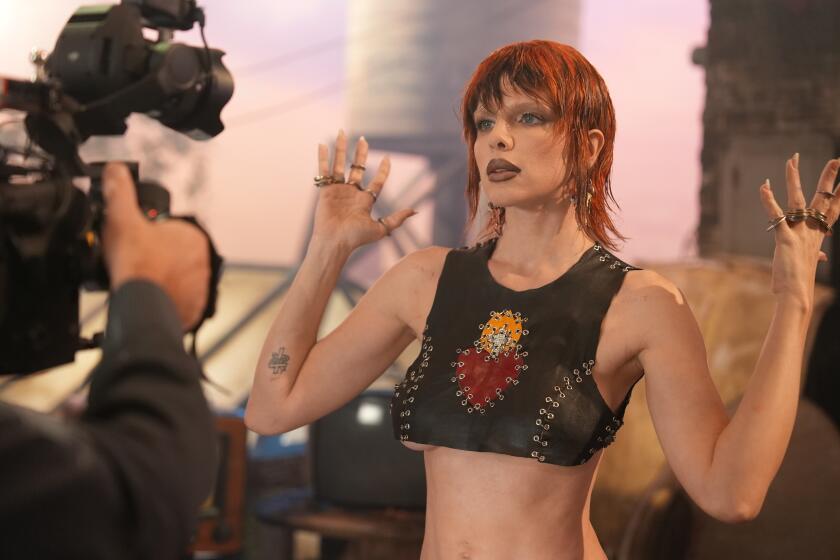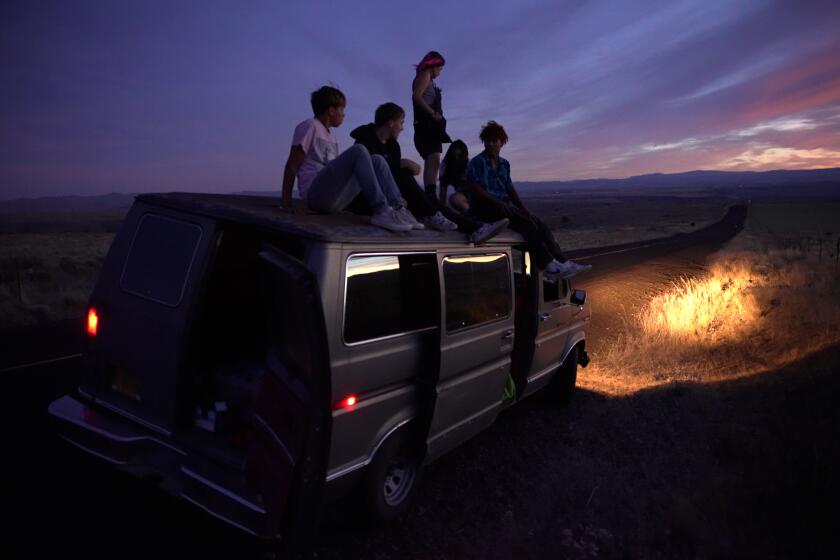Essential Arts: A White House that is — literally — all facade
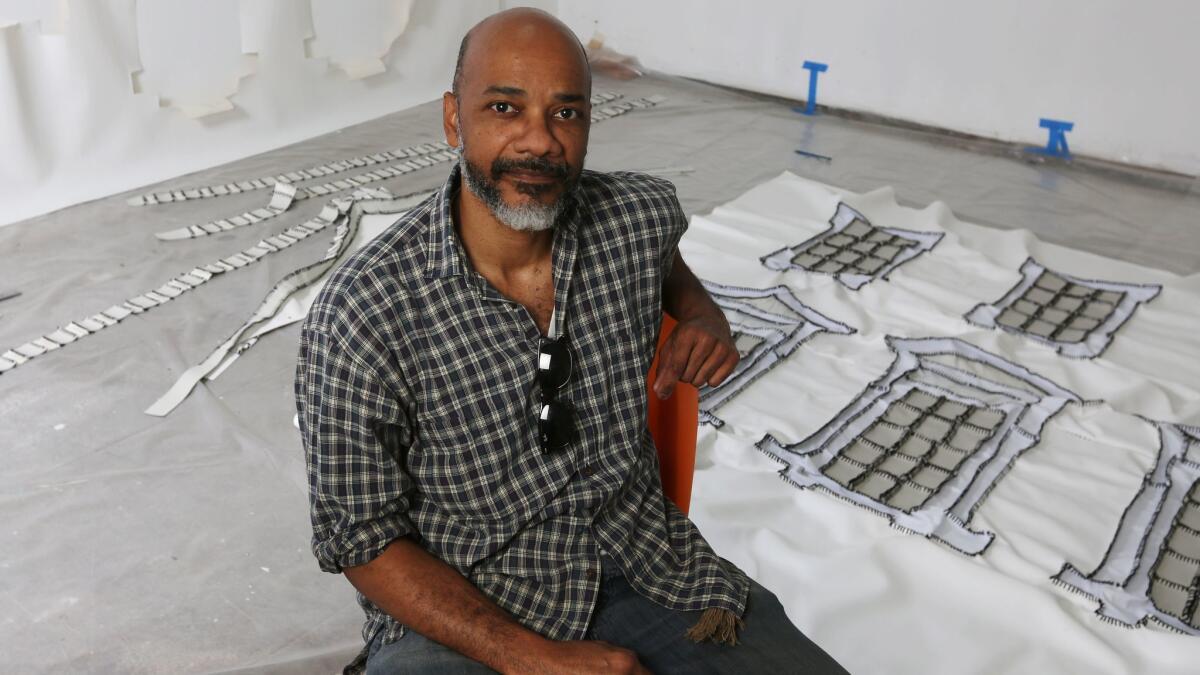
Welcome to these monstrous days between Halloween and Election 2020: End of Days. I’m Carolina A. Miranda, arts and urban design columnist at the Los Angeles Times, and I’ve got lots of essential arts.
A flimsy front
It is a week in which all talk is about the White House and who gets to inhabit it next, so it seems right to pay the White House a visit. Not the actual White House in Washington, D.C., but the facsimile that L.A. artist Rodney McMillian has on display at Vielmetter Los Angeles.
This White House is all facade: a scrim crafted out of scraps of white vinyl sewn together by hand to create a crude, one-dimensional approximation of the U.S. president’s home. It is a newer version of a piece that McMillian constructed for his first solo exhibition in 2018 at the Contemporary Austin in Texas.
On that occasion, I spoke with the artist about the work and what it reveals about our political system: a graceful, idealistic facade behind which resides the ugly residue of our history. (The actual White House was built, in part, by enslaved laborers.) Structures such as the White House represent important sites of “power and indoctrination,” he said at the time.
As we careen toward the election, “White House II,” as the installation is titled, takes on added significance. There is its almost fragile nature: a symbol of power transformed into something pliable, something that could be easily torn apart. It also comes amid a fierce debate on the nature of monuments and what those monuments represent — both overtly and through their aesthetics.
Make the most of L.A.
Get our guide to events and happenings in the SoCal arts scene. In your inbox once a week.
You may occasionally receive promotional content from the Los Angeles Times.
Scholar Lyra D. Monteiro published a must-read essay earlier this week examining the nature of our monument design and what those designs convey. It is a rigorous examination of the ways in which Neoclassical architecture and Classical sculpture have been used to define a United States born and representative of whiteness, and by extension, white supremacy.
McMillian’s White House raises those same issues — albeit in sculptural form. And to stand before it is to viscerally come to terms with those legacies.
His solo show “Body Politic” at Vielmetter Los Angeles is on view through Dec. 5. Visits are by appointment via this link. Do not miss.
Art and the election
Since we’re on the art and politics beat: “Regardless of the outcome of the 2020 election, the fabric of the nation must be repaired,” writes Times theater critic Charles McNulty, “and no one is excused from this necessary work.”
In a pre-election essay for a special issue of Sunday Calendar he looks at the role art and artists can have in this process. “Not everything need be about Trump,” he adds. “But if this figure of obsession cannot be resisted, let’s at least adopt a wider focus, one that recognizes him as more of a symptom than a cause.”
In the meantime, I look at how the foundational U.S. myth of rugged individualism has morphed into something that better resembles toxic individualism — evident in the ongoing disdain for masks in some sectors (such as the White House!). Perhaps it’s time to center our national ethos around foundational stories of a more collective nature, such as barn-raising. “Because we’re not getting through this pandemic as individuals. Like it or not, we’re in this together.”
Other essays in the issue ask “Can we bridge our cultural divide?” Film critic Justin Chang looks at democracy and the movies — how these acts of solidarity that thrive on public togetherness are under threat. TV critic Robert Lloyd provides a field guide to the internet comedians who made their names poking Trump and anticipated what will happen after the election. Game critic Todd Martens examines how politics have invaded the game space — it’s not just AOC on Twitch; even Joe Biden‘s campaign has his own “Animal Crossing” island. And Company Town reporter Stephen Battaglio looks back at Rock the Vote on its 30th anniversary and the state of the youth vote today.
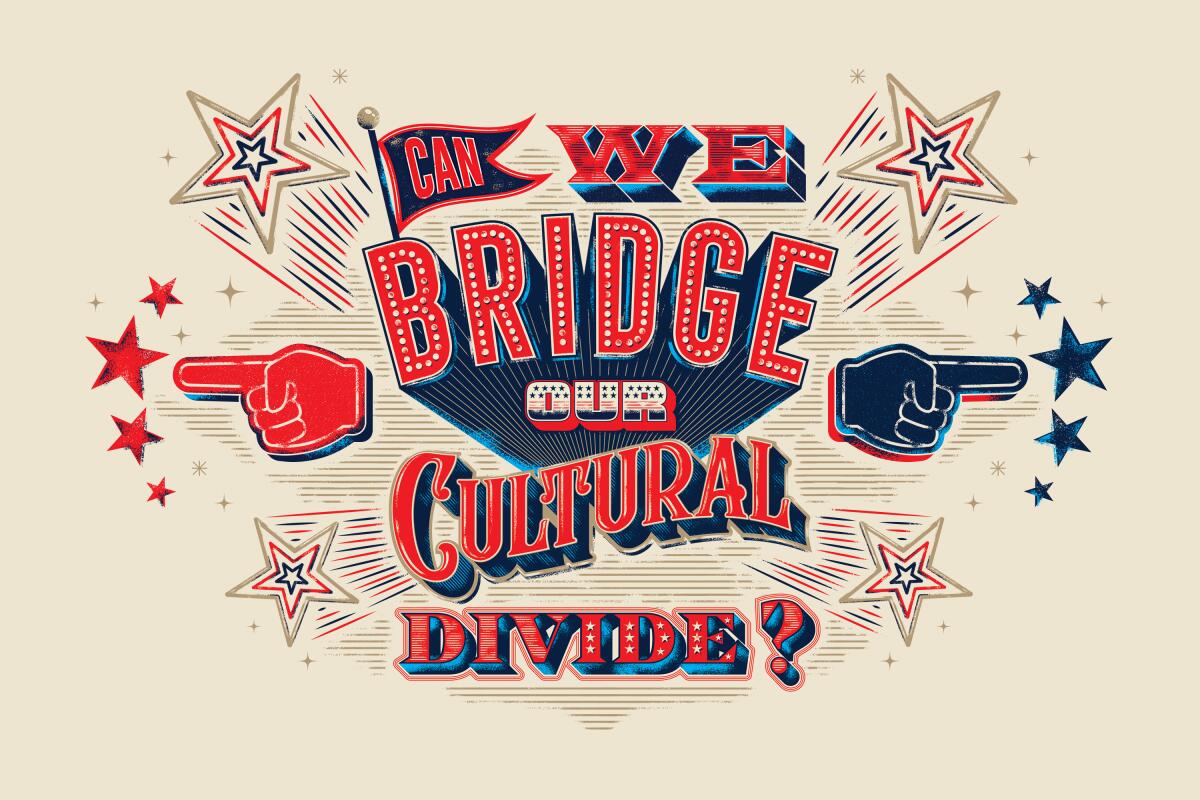
Art in the time of coronavirus
Because we could all use a little bit of delightful reading at this moment, Times art critic Christopher Knight comes through with 10 artsy coffee table books to get us through the pandemic. It’s got a pinch of Goya, a sprinkling of Guerrilla Girls, a dash of Anni and Jose Albers, and plenty of sensuous Bernini. ¡Ay mamá!
Enjoying this newsletter? Consider subscribing to the Los Angeles Times
Your support helps us deliver the news that matters most. Become a subscriber.
Times classical music critic Mark Swed reports that the pandemic has sorely tested the L.A. Phil. (By next summer it will have lost an estimated $90 million in projected revenue.) But in the intervening months, the orchestra has been testing other outlets for its music: radio, TV, streaming video, DVD/Blu-Ray and even vinyl. “Each in its own way reminds us of what we’re missing,” he writes. “But each also adds a dimension.”
The Finnish National Opera is back to doing live opera — and thankfully for the rest of us, its new show, directed by Esa-Pekka Salonen, is available for free streaming. In a nod to the pandemic, it is an operatic spoof of “Cosi Fan Tutte” called “Covid Fan Tutte.” And it is “brilliant,” writes Swed, a “transcendent Mozartean spoof ... unlike anything else that the coronavirus has wrought.”
Plus, Swed — who, pandemic or no pandemic, remains relentless — has the latest dispatch in his series on listening: This week, he takes on Gustav Mahler’s “Eighth Symphony” — the “most extravagant, most rapturous, most ecstatic, most blissful, most all-consuming symphony.” (Find the whole series here.)
COVID-19 has resulted in the advent of the drive-in dance show. The Times’ Makeda Easter goes behind the scenes on a new show by L.A. Dance Project that was choreographed by a pair of former members of the Batsheva Dance Company. The safety procedures were rigorous, she notes. But “Solo at Dusk,” as the piece is titled, “felt like stumbling into a secret ritual.”
And even though most theaters in the U.K. remain closed, Britain’s delayed Laurence Olivier Awards were staged as a prerecorded event streamed online. Actors Ian McKellen, Andrew Scott (aka the hot priest on “Fleabag”) and Sharon D. Clarke were among the acting winners.
Skate land
While others were making sourdough, Makeda Easter has been re-learning to roller skate. The process has connected her to a long-running culture of Black skaters in L.A. “As an L.A. transplant, learning to skate and spending time with Black skaters in particular has made me feel more connected to this city and to a unique culture and style,” she writes, “one that has been popularized by social media but whose origins are not always properly acknowledged.”
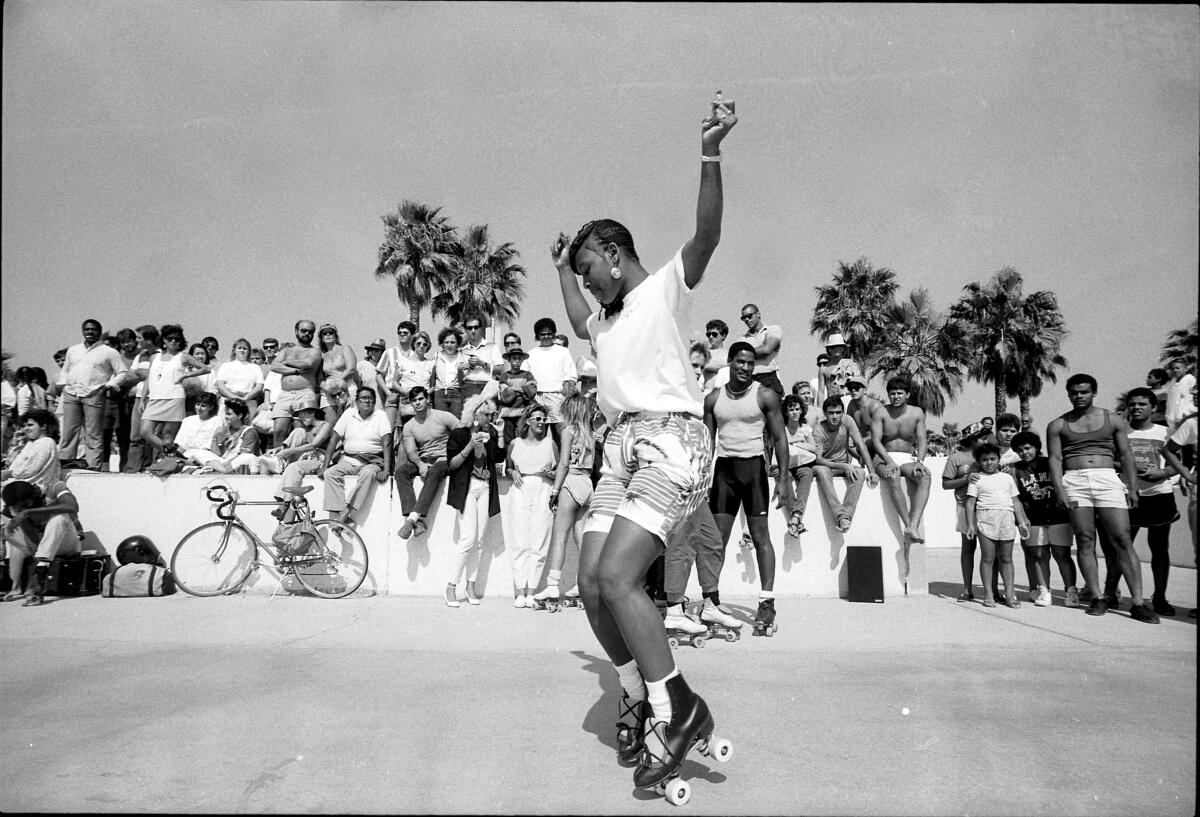
In the museum world
With just two hours to go, the Baltimore Museum of Art put plans to sell three valuable canvases by Andy Warhol, Clyfford Still and Brice Marden on pause. The proposed sale led two prominent former board chairmen to rescind verbal pledges and two artist trustees to step down, and it drew a public statement from the professional organization that governs deaccessions. The Times’ Deborah Vankin has all the deets.
In an earlier column, art critic Christopher Knight had described the move as redolent of a “cringe-inducing carelessness.”
Still, the Palm Springs Art Museum sold Helen Frankenthaler’s “Carousel” at Sotheby’s for $4.7 million — which was over the high estimate. And the Brooklyn Museum unloaded seven works by various artists, including Matisse, Monet and Joan Miró, raking in $20 million. The New York Times’ Hilarie Sheets explores why that latter sale hasn’t generated as much controversy.
Since too much controversy is never enough: After four museums announced that they would postpone a traveling Philip Guston exhibition until 2024, generating a public backlash, they have shifted position and announced that the show will now open in 2022. In addition, the Art Newspaper reported that Tate Modern curator Mark Godfrey has been suspended after making public comments critical of the postponement.
Leaders at various New York City museums are wondering how long they’ll be able to function at 25% capacity. In L.A., The Times’ editorial board says it’s time to reopen museums.
In the galleries
This week, Christopher Knight checks out Kahlil Joseph’s “BLKNWS®,” which is on view in various locations around Los Angeles as part of the Hammer Museum’s “Made in L.A.” biennial, in collaboration with Los Angeles Nomadic Division. “Like the collaged newspapers on a Cubist cafe table painted next to a cup of coffee or a glass of wine,” writes Knight, “ ‘BLKNWS®’ invites contemplation, which is something CNN and Fox rarely summon.”
Contributor Mimi Zeiger has a look at the more than 50 toilet paper holder designs at Marta in Echo Park, which range from elegantly functional to downright bizarre. The show may be whimsical, but it has a message, she writes: “It takes 37 gallons of clean water and a cocktail of bleach and formaldehyde to produce that quilted white roll we’ve come to expect next to the toilet — and nearly a third of the market is controlled by Koch Industries, according to the gallery.”
The Art, Design & Architecture Museum at UC Santa Barbara has an interesting online presentation about California Modernist Walter S. White (1917-2002), known for his saddle-shaped roofs and an interest in creating affordable and D.I.Y. housing to contend with the post- World War II housing crunch.
Essential happenings
Matt Cooper has all the latest digital cultural happenings, with 16 culture picks that include a performance by jazz saxophonist and composer Kamasi Washington, who is performing his score for a recent documentary about Michelle Obama as part of the LA Phil’s “Sound/Stage” series.

He also comes through with a lengthy list — 18 events! — for how to celebrate Halloween and Día de Los Muertos, both virtually and IRL. This includes a haunted hayride in San Dimas that opts for automobiles instead of hay wagons and the essential Day of the Dead altars in Grand Park.
Plus, Mark Swed highly recommends taking 40 minutes to watch the Kronos Quartet’s “Testimony,” a film that is being presented by Stanford Live. In addition to music, the film features spoken-word performances by various poets and, as Swed reports, “is an extraordinary look at our moment — racially, politically, socially and musically.” Starting with the wild opening performance of “The Star-Spangled Banner,” it will grab you by the ear buds and not let go. “Testimony” streams for free through Monday.
In other news
— The L.A. Times has a new newsletter! The Latinx Files will be stewarded by my colleague Fidel Martinez and will cover all things Latino.
— Everybody: We want a more equitable art world! Newfields in Indianapolis: What if we take out all of the contemporary art and replace it with an Instagram-friendly, immersive Van Gogh installation?
— Cardi B and Megan Thee Stallion have macaroni in a pot. Rich Orange County-ites have a Dale Chihuly in a net. Get ready to read the most insane rich-people neighbor squabble of all time.
— Sahra Sulaiman has an interesting report at Streetsblog about how a lot in South L.A. will be turned into a supportive boarding school for underserved youth in partnership with Metro and L.A. County.
— It took Hollywood 13 years to open a Target store, and Curbed’s Alissa Walker has things to say about its design: “This Target is a giant, life-size time capsule of everything that was wrong with L.A. in 2007 and everything that’s still wrong with L.A. in 2020.”
— L.A. architect Michael Lehrer, founder of Lehrer Architects, a firm known for its institutional designs, as well as community projects such as the Aetna Street Bridge Home in Van Nuys, is the winner of the AIA LA‘s Gold Medal for 2020.
— Chilean architect Alejandro Aravena has been named chair of the Pritzker Architecture Prize jury.
— MLB merch is getting fancy: A minimalist poster shows off the architecture of Dodger Stadium. #GoDoyers
— Since it’s decorative gourd season, here are some Getty-inspired pumpkins.
— Also, The Times’ music team has come up with the ultimate Halloween-in-quarantine playlist.
And last but not least ...
Not on the playlist, but should be: Pacoima Techno with some plushie Goth techno. You’re welcome, art world. You’re welcome.
The biggest entertainment stories
Get our big stories about Hollywood, film, television, music, arts, culture and more right in your inbox as soon as they publish.
You may occasionally receive promotional content from the Los Angeles Times.


